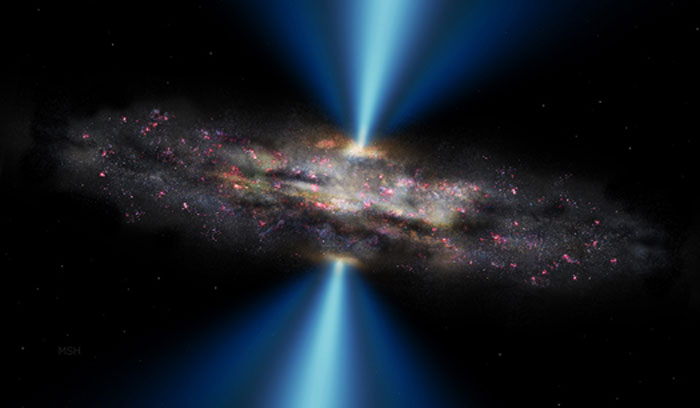.

Credit: Illustration: M. Helfenbein, Yale University / OPAC
Researchers have discovered a black hole that grew much more quickly than its host galaxy. The discovery calls into question previous assumptions on the development of galaxies.
The black hole was originally discovered using NASA's Hubble Space Telescope, and was then detected in the Sloan Digital Sky Survey and by ESA's XMM-Newton and NASA's Chandra X-ray Observatory.
Benny Trakhtenbrot, from ETH Zurich's Institute for Astronomy, and an international team of astrophysicists, performed a follow-up observation of this black hole using the 10 meter Keck telescope in Hawaii and were surprised by the results. The data, collected with a new instrument, revealed a giant black hole in an otherwise normal, distant galaxy, called CID-947. Because its light had to travel a very long distance, the scientists were observing it at a period when the universe was less than two billion years old, just 14 percent of its current age (almost 14 billion years have passed since the Big Bang).
An analysis of the data collected in Hawaii revealed that the black hole in CID-947, with nearly 7 billion solar masses, is among the most massive black holes discovered up to now. What surprised researchers in particular was not the black hole's record mass, but rather the galaxy's mass. "The measurements correspond to the mass of a typical galaxy," says Trakhtenbrot, a postdoctoral fellow working within the Extragalactic Astrophysics research group of Professor Marcella Carollo. "We therefore have a gigantic black hole within a normal size galaxy." The result was so surprising that two of the astronomers, including Hyewon Suh from the Harvard-Smithsonian Center for Astrophysics (CfA) in Cambridge, MA, had to verify the galaxy mass independently. Both came to the same conclusion. The team reports its findings in the current issue of the scientific journal Science.
Was anything different in the early Universe?
Most galaxies, including our Milky Way, have a black hole at their center that holds millions to billions of solar masses. "Black holes are objects that possess such a strong gravitational force that nothing – not even light – can escape. Einstein's theory of relativity describes how they bend space-time itself," explains ETH professor Kevin Schawinski, co-author of the new study. The existence of black holes can be proven because matter is greatly accelerated by the gravitational force and thus emits particularly high-energy radiation.
Until now, observations have indicated that the greater the number of stars present in the host galaxy, the bigger the black hole. "This is true for the local universe, which merely reflects the situation in the Universe's recent past," says Trakhtenbrot. This link, along with other evidence, led the scientists to assume that the growth of black holes and the formation of stars go hand-in-hand. This is quite reasonable, if a common reservoir of cold gas was responsible for the formation of the stars and the 'feeding' of the black hole at the galaxy's center, says Trakhtenbrot. Furthermore, previous studies suggested that the radiation emitted during the growth of the black hole controlled, or even stopped the creation of stars, as the released energy heated up the gas. The latest results, however, suggest that these processes work differently, at least in the early universe.
Star formation continues
The distant young black hole observed by Trakhtenbrot and his colleagues weighs about 10% of its host galaxy's mass. In today’s local universe, black holes typically reach a mass of 0.2% to 0.5% of their host galaxy's mass. "That means this black hole grew much more efficiently than its galaxy – contradicting the models that predicted a hand-in-hand development," explains the ETH researcher. From the available Chandra data for this source, the researchers also concluded that the black hole had reached the end of its growth. However, other data suggests stars were still forming throughout the host galaxy. Contrary to previous assumptions, the energy and gas flow, propelled by the black hole, did not stop the creation of stars.
The galaxy could continue to grow in the future, but the relationship between the mass of the black hole and that of the stars would remain unusually large. The researchers believe that CID-947 could thus be a precursor of the most extreme, massive systems that we observe in today’s local universe, such as the galaxy NGC 1277 in the constellation of Perseus, some 220 million light years away from our Milky Way. They hope to gain further insight into the links between the black hole and the host galaxy, through observations with the Alma radio telescope in Chile.
The black hole was selected from a 2011 paper published by Francesca Civano, from Yale University in New Haven, CT and CfA, as part of the Chandra Cosmic Evolution Survey. The full list of authors of the Science paper are Benny Trakhtenbrot ; Megan Urry from Yale University in New Haven, CT; Francesca Civano; David Rosario from the Max Planck Institute for Astrophysics in Garching, Germany; Martin Elvis from CfA; Kevin Schawinski; Hyewon Suh; Angela Bongiorno from the National Institute for Astrophysics in Rome, Italy and Brooke D. Simmons from Oxford University in the UK.
NASA's Marshall Space Flight Center in Huntsville, Alabama, manages the Chandra program for the agency's Science Mission Directorate in Washington. The Smithsonian Astrophysical Observatory in Cambridge, Massachusetts, controls Chandra's science and flight operations.
Quelle: NASA
4327 Views
